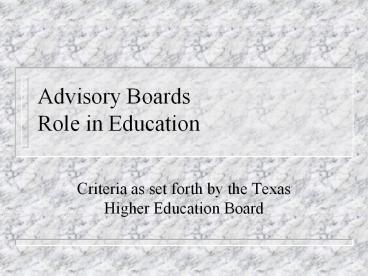Advisory Boards Role in Education PowerPoint PPT Presentation
1 / 20
Title: Advisory Boards Role in Education
1
Advisory Boards Role in Education
- Criteria as set forth by the Texas Higher
Education Board
2
Advisory Board - broad purposes
- to help a college document the need for a
workforce education program - to ensure that the program has both adequate
resources and a well-designed curriculum to
provide students with the skills, knowledge, and
attitudes necessary to successfully meet the
needs of business and industry.
3
Functions of an Advisory Committee
- evaluation of the goals and objectives of the
program curriculum - establishment of workplace competencies for the
program occupation(s) - suggestion of program revisions as needed
4
Functions of an Advisory Committee
- evaluation of the adequacy of existing college
facilities and equipment - advice on the selection and acquisition of new
college equipment - identification of local business/industry
leaders who will provide students with external
learning experiences, employment, and placement
opportunities
5
Functions of an Advisory Committee
- assistance in the professional development of the
faculty - assistance in promoting and publicizing the
program to the community and to business and
industry - representation of the needs of students from
special populations.
6
Advisory Committee Composition
- Advisory committees must be composed of persons
who broadly represent the demographics, including
the ethnic and gender diversity, of the
institution's service area as well as the
demographics of the occupational field. Committee
members should be knowledgeable about the skills
used in the occupation for which they are
providing information and guidance.
7
Advisory Committee Composition
- Members should be drawn from the private and
public sectors, with emphasis on business,
industry, and labor membership. - Tech-Prep program-specific advisory committee
members must represent secondary and higher
education as well as business and industry.
8
Advisory Committee Composition
- Full-time faculty and staff of the community or
technical college offering the program must not
be members of the advisory committee but may
serve in an ex-officio role. Part-time faculty
who hold full-time positions within the career
field may be members of the committee. Faculty
and staff of senior institutions with whom the
program may be articulated may also be members of
the committee.
9
Identification of Program Competencies
- A program must consist of a curriculum which
integrates necessary academic and workforce
skills as identified in the literature, by
program experts, by business and industry
advisory committees, in recognized skill
standards, and by other related professional
organizations. Development of a competency-based
curriculum requires identification of both
subject area specific and general academic and
workforce skills.
10
Needs Analysis
- Conduct a survey of local businesses to find out
the need of a particular job classification in
the area. - Many times government will have figures showing
the need of a particular occupation.
11
Developing Partnerships in the community
- Set up agreements with local businesses to
provide sites for On the job training for the
students. - They can support your program with resources.
- Speak on behave of your program.
12
Internships
- What is your intent of the Internship/Practicum?
- How much knowledge do they need before they start?
13
Certification Process
Setting standards for required skill for a
particular job classification. Decide on what is
needed. Level of education hours of work in the
field passing a competency exam.
14
Accountability
- Texas Board of Education
- Southern Accreditation Board
- Licensing Agencies
15
Accountability
- 85 pass rate on licensing exams
- 95 placement rate for jobs or higher education
- Show Advisory Board input
- Show resources available to students
- Show Scans Skill in syllabus
- Show objectives for each class
16
Health Science Division
- Southeast College
- 17 different programs
- All have an advisory board
- Most have a licensing board for their students
- Some licenses are based solely on education and
an exam - Other require an additional number of hours in
their respective field.
17
Class hours
- 1 credit equal 15/16 hours
- equivalent of one hour per week in a 16 week
semester. (for a ten week semester it would be
1.6 hours - Most classes are either 3 or 4 semester hours
18
Degrees
- Associate Degree 60
- Bachelors Degree 120
- Masters Degree and PHD is variable
19
Degree Plan
- DAAC 1417 - 4 hour
- ENGL 1301 3 hrs
- Psyc 1301 3 hrs
- etc.
- Total hours 65
- A full time student is considered to have at
least 12 hours - A part time student less then 12 hours.
20
Key Internet addresses
- www.hccs.cc.tx.us
- Go to the student section - Click on Degrees -
then click on Workforce or Academic - or Southeast College then Health Science programs
- Rosing_r_at_hccs.cc.tx.us

